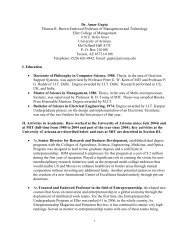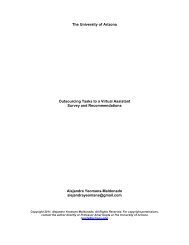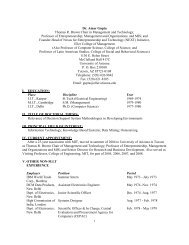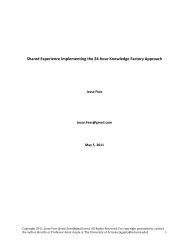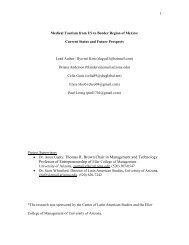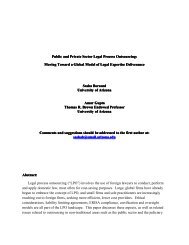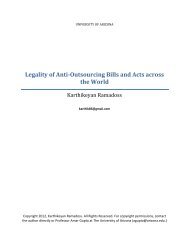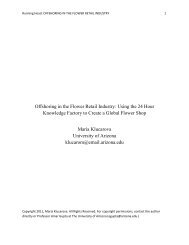Sex Tourism in Cuba: A Tale of Survival - University of Arizona
Sex Tourism in Cuba: A Tale of Survival - University of Arizona
Sex Tourism in Cuba: A Tale of Survival - University of Arizona
You also want an ePaper? Increase the reach of your titles
YUMPU automatically turns print PDFs into web optimized ePapers that Google loves.
<strong>Sex</strong> <strong>Tourism</strong> <strong>in</strong> <strong>Cuba</strong>: A <strong>Tale</strong> <strong>of</strong> <strong>Survival</strong><br />
Copyright 2007-2008, Hyo-mi Kim. All Rights Reserved. For copyright permissions,<br />
contact the author directly or Pr<strong>of</strong>essor Amar Gupta (gupta@eller.arizona.edu) at the<br />
<strong>University</strong> <strong>of</strong> <strong>Arizona</strong>
Hyo Mi Kim<br />
Dr. Gupta<br />
November 30, 2008<br />
ENTR 589<br />
<strong>Sex</strong> <strong>Tourism</strong> <strong>in</strong> <strong>Cuba</strong>: A <strong>Tale</strong> <strong>of</strong> <strong>Survival</strong><br />
<strong>Cuba</strong> is famous for its beautiful beaches, jazz music, and enthusiastic dance, a<br />
tropical island with diverse cultures and races. The other side <strong>of</strong> co<strong>in</strong> is that people do not<br />
know about a tourism <strong>in</strong>dustry <strong>in</strong> <strong>Cuba</strong> that is thriv<strong>in</strong>g, sex tourism. In fact, s<strong>in</strong>ce the<br />
breakdown <strong>of</strong> Soviet Union, sex tourism <strong>in</strong> <strong>Cuba</strong> has been the fastest grow<strong>in</strong>g sector for<br />
more than a decade. This paper will analyze the history <strong>of</strong> sex tourism <strong>in</strong> <strong>Cuba</strong> <strong>in</strong> three<br />
periods: pre-revolution, dur<strong>in</strong>g the revolution, and after the collapse <strong>of</strong> the Soviet Union.<br />
Also, the paper will <strong>in</strong>clude a discussion <strong>of</strong> the driv<strong>in</strong>g forces beh<strong>in</strong>d the sex tourism<br />
<strong>in</strong>dustry <strong>in</strong>clud<strong>in</strong>g political, social, and economic factors and the <strong>Cuba</strong>n government’s<br />
prevention measures aga<strong>in</strong>st prostitution. The status quo <strong>of</strong> current sex tourism <strong>in</strong> <strong>Cuba</strong><br />
will be thoroughly analyzed; however, this paper does not cover child sex or homosexual<br />
prostitution. The focus <strong>of</strong> the paper will be heterosexual prostitution. Lastly, it will<br />
<strong>in</strong>clude the potential <strong>of</strong> sex tourism <strong>in</strong> <strong>Cuba</strong> <strong>in</strong> the future s<strong>in</strong>ce the new adm<strong>in</strong>istration <strong>of</strong><br />
Barack Obama proposes lift<strong>in</strong>g restriction on travel and the send<strong>in</strong>g remittances to <strong>Cuba</strong><br />
by <strong>Cuba</strong>n Americans. With the elim<strong>in</strong>ation <strong>of</strong> all restrictions on travel to <strong>Cuba</strong> for United<br />
States citizens as well as eas<strong>in</strong>g the embargo on <strong>Cuba</strong> that is almost 50 years old, the<br />
impact <strong>of</strong> these policies will be tremendous on the overall <strong>Cuba</strong>n tourism <strong>in</strong>dustry,<br />
especially the sex tourism sector.<br />
2
Overview<br />
History <strong>of</strong> sex tourism <strong>in</strong> <strong>Cuba</strong><br />
Pre-revolution Era<br />
Before Fidel Castro’s revolution <strong>in</strong> 1959, <strong>Cuba</strong> was mostly a male dom<strong>in</strong>ated<br />
society. Apparently, men were the dom<strong>in</strong>ant figures who were the bread w<strong>in</strong>ners and<br />
providers for families, and they had better access to education, politics, and employment.<br />
Women’s roles were limited to the domestic: the submissive wife, nurtur<strong>in</strong>g mother, and<br />
well-behaved daughter. On the other hand, prior to the revolution prostitution took place<br />
<strong>in</strong> Havana when young women migrated from rural areas to Havana <strong>in</strong> order to f<strong>in</strong>d<br />
employment (Trumbull, 2001, p.357). <strong>Sex</strong> workers were considered victims <strong>of</strong><br />
imperialism with a second citizen social status (Clancy, 2002, p.64). The <strong>Cuba</strong>n<br />
government has estimated that as many as 100,000 prostitutes were <strong>in</strong> the country<br />
(Trumbull, 2001, p.357). Supply can not exist without demand. Every year, hundreds <strong>of</strong><br />
thousands <strong>of</strong> travelers and bus<strong>in</strong>essmen came to <strong>Cuba</strong> for illicit sex and gamble.<br />
Dur<strong>in</strong>g the Revolution<br />
After Fidel Castro achieved his victory <strong>of</strong> the revolution, he declared that <strong>in</strong> a<br />
socialist society nobody needed to sell their body for money. The rhetoric <strong>of</strong> revolution<br />
guaranteed to <strong>Cuba</strong>n women safeguards aga<strong>in</strong>st foreigners and prostitution (Clancy, 2002,<br />
p.64). Women were liberated and atta<strong>in</strong>ed equal opportunity through the socialist<br />
revolution. The <strong>Cuba</strong>n government strived to <strong>in</strong>corporate women <strong>in</strong>to society and the<br />
work force, and women were viewed as valuable assets who would <strong>in</strong>crease production<br />
levels as well as enhance the economy. Women had the same access to education and<br />
3
employment as men. These promises were susta<strong>in</strong>ed by $ 4 billion <strong>in</strong> annual Soviet<br />
subsidies, and <strong>Cuba</strong>ns could make ends meet and there was no need to participate <strong>in</strong><br />
prostitution (Trumbull, 2001, p.356). The government <strong>in</strong>vested the subsidies to boost<br />
educational levels and the healthcare system. As a whole, the sex bus<strong>in</strong>ess became an<br />
unnecessary sector <strong>of</strong> the society and dim<strong>in</strong>ished <strong>in</strong> the years before the collapse <strong>of</strong> the<br />
Soviet Union.<br />
After the Collapse <strong>of</strong> the Soviet Union<br />
The breakdown <strong>of</strong> the Soviet Union entirely changed the stable economic<br />
conditions <strong>in</strong> <strong>Cuba</strong>. In 1991, the subsidies vanished with the collapse <strong>of</strong> the Soviet Union<br />
and so did trad<strong>in</strong>g partnerships with Eastern European countries (Trumbull, 2001, p.358).<br />
As a result, the citizens <strong>of</strong> <strong>Cuba</strong> suffered a great deal <strong>of</strong> hardship: lack <strong>of</strong> basic<br />
commodities (soaps, gas, food, medic<strong>in</strong>es, clothes, electricity, appliances, furniture etc.)<br />
and the country’s GDP plummeted precipitously. In 1991, the economy plunged by 25%,<br />
and worse yet, another 14.8% <strong>in</strong> 1993 (Clancy, 2002, p.78). The majority <strong>of</strong> <strong>Cuba</strong>n trade,<br />
more than 80%, had been with the communist bloc (Eastern Europe, East Germany, and<br />
the Soviet Union) (Clancy, 2002, p.78). The <strong>Cuba</strong>n government was not able to either<br />
provide all essential items for <strong>Cuba</strong>ns or <strong>in</strong>vest money on <strong>in</strong>frastructure. All <strong>of</strong> <strong>in</strong>dustries<br />
<strong>in</strong> <strong>Cuba</strong> are state owned, and thus the disappearance <strong>of</strong> the Soviet subsidies shrank public<br />
expenditure, lead<strong>in</strong>g to high unemployment rates and a low real wage level. Under the<br />
circumstances, <strong>Cuba</strong>ns were forced to search for ways to overcome this turmoil and<br />
economic pandemonium <strong>in</strong> order to survive. The reemergence <strong>of</strong> prostitution was an<br />
obvious byproduct <strong>of</strong> the economic crisis, and prostitution was an effective means <strong>of</strong><br />
survival for women who had to feed their families and make a liv<strong>in</strong>g.<br />
4
Re-emergence <strong>of</strong> Prostitution<br />
The breakdown <strong>of</strong> the Soviet Union <strong>in</strong> 1991 drove <strong>Cuba</strong> <strong>in</strong>to a catastrophic<br />
economic crisis. The <strong>Cuba</strong>n government had to <strong>in</strong>itiate structural reforms to survive<br />
without the Soviet Union’s f<strong>in</strong>ancial support or with trad<strong>in</strong>g partners from Eastern<br />
European countries. First <strong>of</strong> all, <strong>Cuba</strong> needed foreign direct and <strong>in</strong>direct <strong>in</strong>vestment, and<br />
tourism was one <strong>of</strong> ma<strong>in</strong> <strong>in</strong>dustries that the government had planned to use to revive the<br />
economy. Secondly, the <strong>Cuba</strong>n government legalized U.S. dollar possession. This policy<br />
created a “dual economy” <strong>in</strong> <strong>Cuba</strong>, and ord<strong>in</strong>ary people pursued dollars more than ever to<br />
sell or purchase domestic commodities illegally <strong>in</strong> the thriv<strong>in</strong>g black market, the place <strong>in</strong><br />
<strong>Cuba</strong> where only dollars are accepted. Possess<strong>in</strong>g dollars was more mean<strong>in</strong>gful than ever<br />
and it was means <strong>of</strong> survival s<strong>in</strong>ce <strong>Cuba</strong>ns could not live on rations from the state. The<br />
amount <strong>of</strong> food rations last for only two weeks <strong>in</strong> a month or less because <strong>Cuba</strong>’s<br />
agricultural <strong>in</strong>dustry does not produce enough food for <strong>Cuba</strong>ns to feed themselves and<br />
the U.S. blockade makes import<strong>in</strong>g food complicated and expensive (Karsseboom, 2003).<br />
<strong>Cuba</strong>ns have affirmed, “In <strong>Cuba</strong>, if you do not have dollars, you do not have anyth<strong>in</strong>g”<br />
(Karsseboom, 2003). Thirdly, self-employment was also liberalized <strong>in</strong> some fields<br />
(before structural reform all <strong>in</strong>dustries were run by the state). Engag<strong>in</strong>g <strong>in</strong> the tourism<br />
<strong>in</strong>dustry (doormen, bartenders, taxi drivers, waiters etc.) was a tempt<strong>in</strong>g and <strong>in</strong>evitable<br />
alternative to earn dollars and, especially for women, prostitution was a promis<strong>in</strong>g way to<br />
procure those dollars.<br />
Naturally, these structural reforms stirred and molded rapid change <strong>in</strong> the tourist<br />
<strong>in</strong>dustry. Hotels, night clubs, bars and restaurants were constructed to lure tourists from<br />
all over the world. Thanks to deregulation <strong>of</strong> self-employment, <strong>Cuba</strong>ns could work <strong>in</strong><br />
5
different sectors to provide services for tourists: transportation, stores, restaurants,<br />
apartment rental, and so forth. Most importantly, the legalization <strong>of</strong> dollar possession<br />
facilitated the spend<strong>in</strong>g <strong>of</strong> more money <strong>in</strong> <strong>Cuba</strong> by foreign tourists. The tourism <strong>in</strong>dustry<br />
has proliferated <strong>in</strong>credibly; tourism has <strong>in</strong>creased 18.6% every year s<strong>in</strong>ce 1995 (Trumbull,<br />
2001, p.358). Between 1988 and 2000, the number <strong>of</strong> foreign tourists rose from 300.000<br />
to 1.85 million (Clancy, 2002, p.77).<br />
Accord<strong>in</strong>g to the Economic Commission for Lat<strong>in</strong> America & the Caribbean<br />
(ECLAC), tourism employs 81,000 workers directly and simultaneously, and creates a<br />
multiplier effect that generates 2.7 employments for every direct job created (Trumbull,<br />
2001, p.358). The tourism sector drew <strong>in</strong> approximately $2.0 billion <strong>in</strong> 1998, and <strong>Cuba</strong><br />
anticipates 6-7 million foreign tourists to visit the island and spend $10 billion by 2010<br />
(Trumbull, 2001, p.358). As the tourism <strong>in</strong>dustry expands, sex tourism swells as well.<br />
The numbers do not <strong>in</strong>clude American tourists due to the U.S. trade embargo that forbids<br />
visits to <strong>Cuba</strong>. Undoubtedly, if the new adm<strong>in</strong>istration lifts the restrictions on <strong>Cuba</strong> and<br />
allows travel, millions <strong>of</strong> American tourists will flood <strong>in</strong>to <strong>Cuba</strong>, contribut<strong>in</strong>g billions <strong>of</strong><br />
additional dollars to the <strong>Cuba</strong>n economy.<br />
<strong>Sex</strong> tourism is not a new phenomenon; throughout history it has cont<strong>in</strong>ued to exist.<br />
For centuries sex tourism and tourism have been <strong>in</strong>separable around the globe. <strong>Cuba</strong> is<br />
not an exception when it comes to sex tourism. Thousands <strong>of</strong> men visit or travel to <strong>Cuba</strong><br />
to have sex with <strong>Cuba</strong>n girls and most <strong>of</strong> them are Europeans, especially from Italy and<br />
Spa<strong>in</strong>. Accord<strong>in</strong>g to ECLAC, 58% <strong>of</strong> tourists are male 25-60 years old, twice the number<br />
<strong>of</strong> female tourists <strong>of</strong> the same age group (Trumbull, 2001, p.359). Obviously, a<br />
6
substantial number <strong>of</strong> male tourists engage <strong>in</strong> sex tourism <strong>in</strong> <strong>Cuba</strong>, and thus the<br />
proliferation <strong>of</strong> the tourism <strong>in</strong>dustry is partially attributed to sex tourism.<br />
There are a few dist<strong>in</strong>ctive characteristics <strong>of</strong> contemporary prostitution <strong>in</strong> <strong>Cuba</strong>.<br />
Firstly, unlike Thailand, Cambodia, Haiti, and Eastern Europe, there is virtually no<br />
network <strong>of</strong> brothels and pimps, organized systems <strong>in</strong>volv<strong>in</strong>g a third party. Most<br />
prostitutes <strong>in</strong> <strong>Cuba</strong> work voluntarily, <strong>in</strong>dependently, and <strong>in</strong>dividually and work part-time<br />
without <strong>in</strong>volv<strong>in</strong>g any organizations or groups. Simply put, they are not sex slaves who<br />
are kidnapped, abused emotionally and physically, or sold through human traffic. Nobody<br />
forces them <strong>in</strong>to prostitution or to work under harsh and oppressive conditions as <strong>in</strong> third<br />
world countries.<br />
Secondly, <strong>Cuba</strong> has taken pride <strong>in</strong> its excellent educational system and has a<br />
literacy rate <strong>of</strong> 99.8%, second highest <strong>in</strong> the world (United Nation Human Development<br />
Index 2007/2008, p.236; CIA Factbook Literacy Rate) (See Figure 1). In fact, most<br />
<strong>Cuba</strong>n prostitutes are educated and also multi-l<strong>in</strong>gual because the state not only funds<br />
education for all citizens, <strong>in</strong>clud<strong>in</strong>g university education, but women have equal access<br />
and equal rights to pursue high education as do men. Even Fidel Castro has stated that<br />
“<strong>Cuba</strong> has the cleanest and most educated prostitutes <strong>in</strong> the world” (Trumbull, 2001,<br />
p.358).<br />
7
Figure 1 Source: United Nation Human Development Report 2007/2008 and CIA<br />
Factbook, Literacy Rate (age 15 and over can read and write)<br />
World Country Literacy Rate<br />
Rank<br />
%<br />
2 <strong>Cuba</strong> 99.8<br />
18 France 99.0<br />
18 Spa<strong>in</strong> 99.0<br />
18 United K<strong>in</strong>gdom 99.0<br />
65 Chile 95.7<br />
70 Portugal 93.8<br />
83 Mexico 91.6<br />
96 Brazil 88.6<br />
102 Dom<strong>in</strong>ican Rep. 87<br />
104 Bolivia 86.7<br />
154 Haiti 54.8<br />
Another <strong>in</strong>terest<strong>in</strong>g perspective on prostitutes <strong>in</strong> <strong>Cuba</strong> is they are not drug addicts<br />
or alcoholics. Some <strong>of</strong> them engage <strong>in</strong> prostitution to f<strong>in</strong>ance their studies or to work <strong>in</strong> a<br />
chosen pr<strong>of</strong>ession. Also, some women work <strong>in</strong> the sex <strong>in</strong>dustry to susta<strong>in</strong> a certa<strong>in</strong> life<br />
style; prostitutes have access to luxurious and glamorous clubs, bars, restaurants and<br />
clothes that are not available for local people, but only for foreign tourists. The <strong>Cuba</strong>n<br />
laws forbid locals utiliz<strong>in</strong>g tourist designated areas such as high class and top-end clubs,<br />
bars, hotels, and restaurants. Only foreign tourists, who are privileged, have the right to<br />
use these places. Natives are not allowed to enter these places unless they are<br />
accompany<strong>in</strong>g tourists or work there.<br />
8
Factor 1: Economic Necessity<br />
Needless to say, economic need is the pr<strong>in</strong>cipal driv<strong>in</strong>g force <strong>in</strong> the comeback <strong>of</strong><br />
prostitution <strong>in</strong> <strong>Cuba</strong>. The majority <strong>of</strong> sex workers view prostitution as only a means to<br />
make a liv<strong>in</strong>g. Most sex workers work <strong>in</strong> the <strong>in</strong>dustry <strong>in</strong> order to make ends meet<br />
families; participat<strong>in</strong>g based solely upon economic need. A substantial number <strong>of</strong> women<br />
migrants from the countryside turn to prostitution, s<strong>in</strong>ce they are not able to work legally<br />
<strong>in</strong> the city due to <strong>in</strong>ternal migration laws that prohibit them from obta<strong>in</strong><strong>in</strong>g urban<br />
employment (Trumbull, 2001, p.359). Another reason that women choose to enter<br />
prostitution is to f<strong>in</strong>ance their work or studies. Pr<strong>of</strong>essional women workers participate <strong>in</strong><br />
prostitution part time <strong>in</strong> a quest for additional <strong>in</strong>come. <strong>Cuba</strong> is known for dreadfully low<br />
wages: doctors, pr<strong>of</strong>essors, and lawyers are paid approximately $25 per month or less.<br />
The level <strong>of</strong> salary is astonish<strong>in</strong>gly low <strong>in</strong> <strong>Cuba</strong>; accord<strong>in</strong>g to the San Francisco<br />
Chronicle, salary <strong>of</strong> <strong>Cuba</strong>n doctors is only $15 per month (Juan Forero 2007). The<br />
overall average monthly salary is approximately $12 (Trumbull, 2001, p.360). Yet those<br />
figures do not reflect the purchas<strong>in</strong>g power <strong>of</strong> <strong>Cuba</strong>ns because state services provide<br />
many essentials: basic foodstuffs, health care, child care, education, and <strong>of</strong>ten hous<strong>in</strong>g<br />
(Clancy, 2002, p.79).<br />
Notwithstand<strong>in</strong>g, such state support has not been nearly enough for average<br />
<strong>Cuba</strong>ns to live on and the situation has worsened due to the economic crisis after the<br />
collapse <strong>of</strong> the Soviet Union. Overnight, basic necessities such as cook<strong>in</strong>g oil, meat,<br />
detergents, gas, shoes, and gasol<strong>in</strong>e became luxury items. <strong>Cuba</strong>n female workers had to<br />
f<strong>in</strong>d an alternative to support themselves and their families. Pr<strong>of</strong>essionals who have<br />
received university education and advanced degrees still need to f<strong>in</strong>d supplementary<br />
9
sources <strong>of</strong> <strong>in</strong>come. Some <strong>of</strong> them abandon their jobs to acquire a self-employed license<br />
or otherwise work <strong>in</strong> the tourism <strong>in</strong>dustry as doormen, concierges, maids, taxi drivers,<br />
waiters, bartenders, and prostitutes. In reality, prostitution is a lucrative bus<strong>in</strong>ess <strong>in</strong> <strong>Cuba</strong><br />
relative to other sources. The regular rate for a prostitute is $25-$40 per night and <strong>in</strong> the<br />
fancy and luxurious clubs or bars the rate is $80-$100 (Trumbull, 2001, p.361).<br />
The <strong>in</strong>terviews that Trumbull conducted <strong>in</strong> <strong>Cuba</strong> mirror the reality <strong>of</strong> the <strong>Cuba</strong>n<br />
prostitution <strong>in</strong>dustry; two <strong>Cuba</strong>n mulatta (biracial mixture <strong>of</strong> black and white) girls said<br />
they study <strong>in</strong> the day time and work <strong>in</strong> streets at night (Trumbull, 2001, p.360). On<br />
average, these prostitutes charge $25-$70 per night, and hence, if they sleep with one<br />
customer every month, they can earn twice the monthly salary <strong>of</strong> a nurse <strong>in</strong> a hospital.<br />
They mentioned that the salary they received as a nurse is not nearly enough to make a<br />
liv<strong>in</strong>g.<br />
Factor 2: Development <strong>of</strong> Technology-Internet<br />
The <strong>Cuba</strong>n government publicly denies that there is a huge prostitution <strong>in</strong>dustry <strong>in</strong><br />
<strong>Cuba</strong>. Moreover, the government acknowledges the success <strong>of</strong> tourism <strong>in</strong> <strong>Cuba</strong> is driven<br />
entirely by developed <strong>in</strong>frastructures and services for tourists. Fidel Castro proclaimed,<br />
“<strong>Sex</strong> tourism will never be permitted, nor drugs nor anyth<strong>in</strong>g <strong>of</strong> that. This is healthy<br />
tourism, and that is what we want; it is what we promote because we know that today<br />
tourists are worried about their safety and we have conditions to <strong>of</strong>fer them that security”<br />
(Karsseboom, 2003). Yet numerous websites (ex. www.World<strong>Sex</strong>Guide.org) promote<br />
prostitution <strong>in</strong> <strong>Cuba</strong> and exchange <strong>in</strong>formation such as prices and the good spots to f<strong>in</strong>d<br />
prostitutes, the particular bars, clubs, streets, and restaurants (Trumbull, 2001, p.359).<br />
Furthermore, tour operators recruit and promote sex tourism through advertisements <strong>in</strong><br />
10
adult magaz<strong>in</strong>es and through direct mail or email solicitations with personal referrals<br />
from former sex tourists (Karsseboom, 2003).<br />
<strong>Sex</strong> tourists recommend <strong>Cuba</strong> as a paradise <strong>of</strong> sexual tourism. The websites<br />
facilitate shar<strong>in</strong>g or <strong>of</strong>fer<strong>in</strong>g <strong>of</strong> detailed experiences, anecdotes, and stories that guide<br />
foreign tourists to take advantage <strong>of</strong> sex tourism <strong>in</strong> <strong>Cuba</strong>, <strong>in</strong>clud<strong>in</strong>g how to rent private<br />
rooms or houses because <strong>Cuba</strong>n laws prohibit <strong>Cuba</strong>ns from visit<strong>in</strong>g foreigners <strong>in</strong> hotel<br />
rooms, and thus sex tourists need to rent rooms or houses outside <strong>of</strong> hotels s<strong>in</strong>ce they are<br />
not able to <strong>in</strong>vite any <strong>Cuba</strong>n to their own rooms <strong>in</strong> the hotels. The <strong>in</strong>ternet websites have<br />
been heavily promot<strong>in</strong>g sex tourism, accelerat<strong>in</strong>g the growth rate <strong>of</strong> the sex <strong>in</strong>dustry <strong>in</strong><br />
<strong>Cuba</strong>.<br />
Why do tourists choose <strong>Cuba</strong> for sex tourism?<br />
<strong>Cuba</strong> has several advantages that entice tourists for sex tourism and above all for<br />
Europeans who are the majority <strong>of</strong> tourists <strong>in</strong> <strong>Cuba</strong>. Spanish, Italian, Germany, English,<br />
and Canadian male tourists come to <strong>Cuba</strong> to take advantage <strong>of</strong> the affordable price <strong>of</strong><br />
prostitutes. In 1999, sex tourists could spend about $10 for a sexual encounter and if they<br />
wanted a sex worker’s company throughout the even<strong>in</strong>g for d<strong>in</strong>ner and a disco or a bar<br />
that would be only $30-$40 (Wonders, 2001, p.563). Dur<strong>in</strong>g the date the women provide<br />
car<strong>in</strong>g attention with a friendly attitude. While the sex tourists stay <strong>in</strong> <strong>Cuba</strong>, they can<br />
enjoy these k<strong>in</strong>ds <strong>of</strong> high class privileges which they are not able to have <strong>in</strong> their home<br />
countries due to high costs that only a limited number <strong>of</strong> top echelon high society males<br />
can pay for. Additionally, tourists know that it is safer to buy sexual services, s<strong>in</strong>ce<br />
pay<strong>in</strong>g for sex <strong>in</strong> <strong>Cuba</strong> <strong>in</strong>curs less risk <strong>of</strong> be<strong>in</strong>g arrested, penalized or f<strong>in</strong>ed by authorities<br />
compared to <strong>in</strong> their countries (Karsseboom, 2003).<br />
11
However, this is not the whole picture <strong>of</strong> why <strong>Cuba</strong> is becom<strong>in</strong>g famous for sex<br />
tourism <strong>in</strong> the first world. Some sex tourists are not just look<strong>in</strong>g for girls for sex <strong>in</strong> <strong>Cuba</strong>.<br />
They expect companionship or friendship from women with whom they can have dates,<br />
engage <strong>in</strong> <strong>in</strong>terest<strong>in</strong>g conversation, go to discos to dance, and have d<strong>in</strong>ner or travel<br />
together with them <strong>in</strong> <strong>Cuba</strong>. The <strong>Cuba</strong>n women play the roles <strong>of</strong> tour guide, bedmate,<br />
girlfriend, playmate, companion or danc<strong>in</strong>g partner (Wonders, 2001, p.563). <strong>Cuba</strong>n<br />
prostitutes are well-educated and multi-l<strong>in</strong>gual with many hav<strong>in</strong>g pr<strong>of</strong>essional careers<br />
unlike prostitutes <strong>in</strong> Africa, Eastern Europe, or South East Asia. The tourists expect to be<br />
“pseudo boyfriends” or significant others, and they do not want to be treated as clients or<br />
customers (Wonders, 2001, p.563). One Italian sex tourist and also an American stated<br />
that <strong>Cuba</strong>n women are car<strong>in</strong>g and friendly. <strong>Cuba</strong>n prostitutes do not behave like<br />
pr<strong>of</strong>essional hookers who just want money and calculate everyth<strong>in</strong>g. They want to be<br />
your friend and spend more time with you; they care about you and whatever you want to<br />
do, not just sex (Wonders, 2001, p.563).<br />
Additionally, the low <strong>in</strong>cidence <strong>of</strong> HIV/AIDS <strong>in</strong> <strong>Cuba</strong> is quite appeal<strong>in</strong>g to<br />
Europeans, s<strong>in</strong>ce Western European countries are concerned with the grow<strong>in</strong>g rate <strong>of</strong><br />
HIV/AIDS worldwide. <strong>Cuba</strong> has the lowest <strong>in</strong>cidence <strong>of</strong> HIV <strong>in</strong> the Western Hemisphere,<br />
which is a 0.1% adult prevalence rate <strong>in</strong> comparison to Haiti’s 2.02% and the Dom<strong>in</strong>ican<br />
Republic’s 1.07% (See Figure 2) (CIA World Fackbook). Unequivocally, <strong>Cuba</strong> is the<br />
safest country regard<strong>in</strong>g HIV/AIDS among Caribbean nations. Every s<strong>in</strong>gle pregnant<br />
woman receives an HIV test. Remarkably, 96% <strong>of</strong> the total population <strong>of</strong> <strong>Cuba</strong> had been<br />
tested for AIDS by 1994. While other countries <strong>in</strong> Lat<strong>in</strong> America and the Caribbean have<br />
12
struggled with the AIDS epidemic, <strong>Cuba</strong> ma<strong>in</strong>ta<strong>in</strong>s that it is undamaged (Trumbull, 2001,<br />
p.369). Tourists are aware <strong>of</strong> the fact that it is safer for them to have sex with prostitutes<br />
<strong>in</strong> <strong>Cuba</strong> rather than prostitutes <strong>in</strong> Eastern Europe or other Caribbean countries such as<br />
Haiti or the Dom<strong>in</strong>ican Republic. Besides, sex education is mandatory <strong>in</strong> the 6 th or 7 th<br />
grade and condoms are widely available, frequently for free <strong>in</strong> cl<strong>in</strong>ics.<br />
Figure 2 Source: CIA World Factbook, HIV/AIDS Prevalence<br />
*Higher # = Lower Incidence<br />
Country People liv<strong>in</strong>g<br />
with AIDS<br />
Ranked by<br />
HIV/AIDS<br />
population*<br />
HIV/AIDS<br />
adult<br />
prevalence<br />
rate (%)<br />
Date <strong>of</strong><br />
Population<br />
Data<br />
<strong>Cuba</strong> 3,300 125 0.1 2003 est.<br />
Haiti 120,000 045 2.02 2008 est.<br />
Dom<strong>in</strong>ican Rep. 88,000 051 1.07 2003 est.<br />
France 120,000 044 0.4 2003 est.<br />
Spa<strong>in</strong> 140,000 042 0.7 2003 est.<br />
Italy 140,000 039 0.5 2001 est.<br />
United States 984,155 010 0.6 2007 est.<br />
Brazil 660,00 015 0.4 2003 est.<br />
Mexico 160,000 035 0.3 2003 est.<br />
South Africa 5,700,000 001 18.01 2008 est.<br />
Curiously, most <strong>of</strong> female prostitutes are non-white, blacks or mulattas (biracial<br />
mixture <strong>of</strong> black and white). This phenomenon has noth<strong>in</strong>g to with racial discrim<strong>in</strong>ation<br />
or lower economic or social status <strong>in</strong> the society. It is purely due to higher demand for<br />
women <strong>of</strong> color rather than white women (Trumbull, 2001, p.361). In other words, many<br />
European males have sexual fantasies or fetishes fixed on black females or those <strong>of</strong><br />
mixed race. <strong>Cuba</strong> has a substantially high number <strong>of</strong> blacks, mulattas, and those <strong>of</strong> and<br />
13
mixed race with African descent, and this factor creates an ideal environment for sex<br />
tourists, comb<strong>in</strong><strong>in</strong>g a number <strong>of</strong> stereotypes: hot Lat<strong>in</strong>a and sexually untamed African<br />
women or mulattas (Wonders, 2001, p.563). European male tourists have stated that they<br />
highly desire girls that they cannot sex usually have sexual relations with as black women<br />
are rare <strong>in</strong> their countries <strong>in</strong> Western Europe and <strong>in</strong> Canada. The belief that hav<strong>in</strong>g sex<br />
with black women or mulattas will be more excit<strong>in</strong>g, primitive, and un<strong>in</strong>hibited lures<br />
more sex tourists <strong>in</strong>to <strong>Cuba</strong> (Trumbull, 2001, p.361).<br />
Government Policy on <strong>Sex</strong> <strong>Tourism</strong><br />
The <strong>Cuba</strong>n government publicly and openly condemns the prostitution <strong>in</strong>dustry<br />
and claims to want to eradicate it. The government denounces the prostitute as a “social<br />
parasite” (Trumbull, 2001, p.365). Prostitution is not regarded as a form <strong>of</strong> self-<br />
employment, and, moreover, prostitutes do not pay taxes to the state. S<strong>in</strong>ce, prostitution<br />
is not organized and the prostitutes work <strong>in</strong>dividually, it is difficult for the government to<br />
elim<strong>in</strong>ate its roots. What the government might be seen as most concerned with is a<br />
negative image <strong>of</strong> socialism and that it is dysfunctional <strong>in</strong> <strong>Cuba</strong>. Prostitution is one <strong>of</strong> the<br />
<strong>in</strong>dicators that socialism and the <strong>in</strong>fluence <strong>of</strong> socialist values have dim<strong>in</strong>ished. Socialism<br />
condemns the exploitation <strong>of</strong> people <strong>in</strong> the capitalist world and prostitution is a form <strong>of</strong><br />
exploitation that socialists have always ferociously criticized. The government is not<br />
will<strong>in</strong>g to admit the failure <strong>of</strong> the revolution or the socialist system.<br />
Another apprehension that the government has is that <strong>Cuba</strong> is becom<strong>in</strong>g a<br />
notorious country for sex tourism such as Thailand. The government clearly states that<br />
they want more tourists to visit <strong>Cuba</strong>; however, sex tourism is not what <strong>Cuba</strong> wants to be<br />
famous for. <strong>Cuba</strong> wants to promote healthy tourism that attracts families, seniors, and<br />
14
honeymooners. Prostitution <strong>in</strong>vokes a set <strong>of</strong> negative images: alcohol, pornography, sex<br />
slaves, drugs, brothels, pimps, human traffick<strong>in</strong>g, STDs, and HIV/AIDS. One example <strong>of</strong><br />
government action toward elim<strong>in</strong>ation <strong>of</strong> prostitution is that <strong>in</strong> 1996 the government<br />
cracked down and raided prostitutes on Varadero beach (the most popular beach for<br />
foreign tourists) (Trumbull, 2001, p.363). The authorities arrested 7,000 prostitutes along<br />
Varadero beach and <strong>in</strong>vestigated them and the houses they used <strong>in</strong> the area (Clancy, 2002,<br />
p.77). Now it is illegal to rent houses or rooms for <strong>Cuba</strong>ns and also if anybody rents a<br />
house for prostitution the owner <strong>of</strong> the house will lose the house (Trumbull, 2001, p.364).<br />
The government effectively eradicated prostitution <strong>in</strong> Varadero. In response, the tourism<br />
<strong>in</strong>dustry dw<strong>in</strong>dled <strong>in</strong> Varadero. In order to <strong>of</strong>fset the loss <strong>of</strong> tourists, the government<br />
developed several all-<strong>in</strong>clusive resorts to target families, honeymooners, retired couples,<br />
and students. As a result, the tourism <strong>in</strong>dustry has rebounded <strong>in</strong> Varadero (Trumbull,<br />
2001, p.364).<br />
Conclusion<br />
The tourism <strong>in</strong>dustry is a crucial sector that helps to ma<strong>in</strong>ta<strong>in</strong> the economy afloat<br />
and function<strong>in</strong>g. For <strong>Cuba</strong>, tourism was a salvation under a rapid development plan after<br />
the collapse <strong>of</strong> the Soviet Union and Eastern Social bloc followed by a harsh economic<br />
crisis and shortage <strong>of</strong> essential supplies. Amidst economic chaos, tourism was a driv<strong>in</strong>g<br />
force and motive to step out <strong>of</strong> the mire. On the other hand, the new Obama<br />
adm<strong>in</strong>istration is anticipated to gradually elim<strong>in</strong>ate the nearly 50-year-old blockade<br />
aga<strong>in</strong>st <strong>Cuba</strong>, and trade between the two countries will blossom as well as American<br />
tourists will rush <strong>in</strong>. In late 1960, President Eisenhower imposed economic sanctions<br />
15
aga<strong>in</strong>st <strong>Cuba</strong> as a result <strong>of</strong> the success <strong>of</strong> the revolution (Wonders, 2001, p.560). Before<br />
the embargo, 86% <strong>of</strong> the visitors came from the United States (Wonders, 2001, p.560).<br />
These days approximately 3 million tourists come to <strong>Cuba</strong> annually (327,000 <strong>in</strong><br />
1990 and 2,319,000 <strong>in</strong> 2005 with the annual growth rate <strong>of</strong> tourism at 13.2%) (Fornieles<br />
Sanchez, 2006); however, as soon as the restrictions aga<strong>in</strong>st U.S. citizens travel<strong>in</strong>g are<br />
lifted, the number <strong>of</strong> visitors will be doubled or tripled or even quadrupled <strong>in</strong> a few years.<br />
In response, sex tourism will <strong>in</strong>evitably, grow even larger. <strong>Sex</strong> tourism has been<br />
appeal<strong>in</strong>g to foreign tourists, mostly European male visitors thanks to low cost,<br />
radicalized stereotypes (regard<strong>in</strong>g blacks and mulattas), low HIV/AIDS rates, exotic<br />
beaches, and the tropical climate. <strong>Sex</strong> tourists are seek<strong>in</strong>g an “unspoiled dest<strong>in</strong>ation” and<br />
<strong>Cuba</strong> will be the prime candidate for Americans, <strong>of</strong>fer<strong>in</strong>g proximity to the U.S.<br />
(especially from Miami), <strong>in</strong>expensive short distance flights, and most <strong>of</strong> all, reasonable<br />
cost. In 1991, <strong>Cuba</strong> ranked 23 rd <strong>in</strong> tourist dest<strong>in</strong>ations <strong>in</strong> the western hemisphere; <strong>in</strong> 2006<br />
<strong>Cuba</strong> placed 8 th only beh<strong>in</strong>d the U.S., Canada, Mexico, Brazil, Argent<strong>in</strong>a, Puerto Rico,<br />
and the Dom<strong>in</strong>ican Republic (Fornieles Sanchez, 2006). The <strong>Cuba</strong>n M<strong>in</strong>ister <strong>of</strong> <strong>Tourism</strong>,<br />
Manuel Marrero Cruz, has claimed that <strong>Cuba</strong> had experienced a proliferation <strong>of</strong> tourists,<br />
with a 14% annual growth <strong>in</strong> the last fifteen years (Fornieles Sanchez, 2006). To facilitate<br />
this <strong>in</strong>flux <strong>Cuba</strong> <strong>of</strong>fers ten <strong>in</strong>ternational airports with 93 foreign and airl<strong>in</strong>es (Fornieles<br />
Sanchez, 2006).<br />
If 6 million people visit <strong>Cuba</strong> annually, after the lift<strong>in</strong>g <strong>of</strong> the travel prohibition<br />
restrictions, among them 60% would be male visitors and at least 20% <strong>of</strong> tourists might<br />
be <strong>in</strong>volved <strong>in</strong> sex tourism and purchas<strong>in</strong>g sex services cost<strong>in</strong>g at least $100 per visit.<br />
Under this assumption, the sex tourism sector would generate a m<strong>in</strong>imum <strong>of</strong> $72 million<br />
16
each year for the <strong>Cuba</strong>n economy. <strong>Sex</strong> workers earn $40-$50 for provid<strong>in</strong>g one night <strong>of</strong><br />
sex with companionship, which is twice a <strong>Cuba</strong>n university pr<strong>of</strong>essor’s monthly salary<br />
(Wonders, 2001, p.562). Today, an average <strong>Cuba</strong>n needs to have approximately $100<br />
each month to make ends meet <strong>in</strong> Havana, although if they live <strong>in</strong> a rural area, liv<strong>in</strong>g<br />
costs are relatively lower. Government salaries are at most one-fifth or one-sixth or even<br />
one tenth <strong>of</strong> that $100 monthly amount (Karsseboom, 2003). If this phenomenon<br />
cont<strong>in</strong>ues, and the government is not able to raise the real wage levels <strong>of</strong> people and<br />
subsidies beh<strong>in</strong>d basic service rema<strong>in</strong> <strong>in</strong>sufficient, sex tourism will cont<strong>in</strong>ue to prosper<br />
and flourish.<br />
17
Source<br />
• Forero, J., (2007). Wash<strong>in</strong>gton Post..San Francisco Chronicle. “<strong>Cuba</strong>n doctors<br />
defect from Venezuela posts-Castro's program to aid Chavez opens way for<br />
'desertions'”, 2007. Retrieved October 7, 2008, from<br />
http://www.sfgate.com/cgib<strong>in</strong>/article.cgi?file=/c/a/2007/02/25/MNGN4O8FAC1.<br />
DTL<br />
• Sectoral Activities Programme, International Labour., (2001). “Organization,<br />
Human resources development, employment and globalization <strong>in</strong> the hotel,<br />
cater<strong>in</strong>g and tourism sector”. Retrieved November 19, 2008 from<br />
http://www.ilo.org/public/english/dialogue/sector/techmeet/tmhct01/tmhct-r.pdf<br />
• Bureau <strong>of</strong> Inter-American., (2002). “Affairs Zenith and Eclipse: A Comparative<br />
Look at Socio-Economic Conditions <strong>in</strong> Pre-Castro and Present Day <strong>Cuba</strong>”.<br />
Retrieved November 22, 2008 from http://www.state.gov/p/wha/ci/14776.htm<br />
• CIA World Factbook., (2008). “Rank Order - HIV/AIDS - adult prevalence rate”.<br />
Retrieved November 22, 2008 from https://www.cia.gov/library/publications/theworld-factbook/rankorder/2155rank.html<br />
• Landler, M., (2008). New York Times..“Report Calls for Fresh Approach to Lat<strong>in</strong><br />
America”. http://www.nytimes.com/2008/11/24/wash<strong>in</strong>gton/24lat<strong>in</strong>.html?hp<br />
• Wilk<strong>in</strong>son, S., (2008). International Journal <strong>of</strong> <strong>Cuba</strong>n Studies Volume 1 Issue 1<br />
June 2008. “US <strong>Cuba</strong> policy after Bush: succession or transition?” Retrieved<br />
November 26, 2008 from<br />
http://www.cubastudiesjournal.org/londonmet/library/i10016_3.pdf<br />
• Trumbull, C., (2002). “Prostitution and <strong>Sex</strong> <strong>Tourism</strong> <strong>in</strong> <strong>Cuba</strong>”. Retrieved<br />
November 15, 2008 from<br />
http://lanic.utexas.edu/project/asce/pdfs/volume11/trumbull2.pdf<br />
• Clancy, M., (2002). “The Globalization <strong>of</strong> <strong>Sex</strong> <strong>Tourism</strong> and<br />
<strong>Cuba</strong>: A Commodity Cha<strong>in</strong>s Approach”. Retrieved November 15, 2008 from<br />
http://www.spr<strong>in</strong>gerl<strong>in</strong>k.com/content/dbvytcxgae6l2mrg/fulltext.pdf<br />
18
• Karsseboom, J., (2003). Digital Freedom Network. “Poverty Pushes <strong>Cuba</strong>n<br />
Women <strong>in</strong>to <strong>Sex</strong> <strong>Tourism</strong>”. Retrieved November 22, 2008 from<br />
http://www.globalpolicy.org/socecon/develop/2003/0326cuba.htm<br />
• Wonders, N.A. & Michalowski, R., (2001). “Bodies, Borders, and <strong>Sex</strong> <strong>Tourism</strong> <strong>in</strong><br />
a Globalized World: A <strong>Tale</strong> <strong>of</strong> Two Cities—Amsterdam and Havana”. Retrieved<br />
November 22, 2008 from<br />
http://caliber.ucpress.net/doi/pdf/10.1525/sp.2001.48.4.545<br />
• Fornieles L. M., (2006). Havana Journal. “The state <strong>of</strong> <strong>Cuba</strong>n tourism with<br />
statistics”. Retrieved November 26, 2008 from<br />
http://havanajournal.com/travel/entry/the-state-<strong>of</strong>-cuban-tourism-with-statistics/<br />
• CIA, World Factbook., (2008). “<strong>Cuba</strong>”. Retrieved December 6, 2008 from<br />
https://www.cia.gov/library/publications/the-world-factbook/pr<strong>in</strong>t/cu.html<br />
• United Nation, Human Development Report. (2008). “Human Development<br />
Index”, Retrieved December 6, 2008 from<br />
http://hdr.undp.org/en/media/HDR_20072008<br />
19



